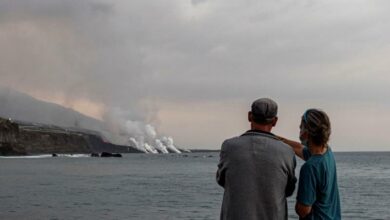Rebuilding from Hurricane Maria going slowly in Puerto Rico

By Jorge J. Muñiz Ortiz
San Juan, Sep 19 (EFE).- Destroyed houses and toppled power poles constitute some of the damage, estimated at $100 billion, caused by Hurricane Maria and still visible in Puerto Rico, where only about 20 percent of the reconstructions projects are under way five years after the storm devastated the island.
On Sept. 20, 2017, Maria – a powerful Category 5 storm packing maximum sustained winds of 160 miles (260 kilometers) per hour – hit southeastern Puerto Rico and passed across the island, flattening much of the infrastructure and many homes along the way.
Maria killed at least 2,975 people and left the entire island without electric power, with thousands of destroyed homes, roads blocked by fallen trees, downed electric lines and virtually all communications shut off.
The most costly rebuilding process in the US or in US territory caused by a natural disaster didn’t get started right away but rather took several years to get going and now the damage from Hurricane Fiona, which hit the island on Sunday, can be added to the remaining devastation from the earlier storm.
“The first three years were to stabilize the emergency due to the magnitude of the devastation,” the director of the Central Office for Recovery, Reconstruction and Resiliency (COR3), Manuel Laboy, told EFE.
Some 10,000 projects are scheduled, of which 1,000 have been completed and about 2,700 are under way, according to Laboy, who said that “between 20 and 25 percent” of the recovery process has been finished or launched.
The work is being supported by the Federal Emergency Management Agency (FEMA), which has been working hand in hand with COR3 since just days after Maria, when the latter agency was created.
Laboy insisted that 2017 cannot be used “as a reference point” for the beginning of permanent reconstruction projects because “allocated” funds authorized by FEMA were not available until 2020 and “all the municipalities and agencies had to be organized” to undertake the work.
“The majority of that money became available and was allocated starting in 2020 and 2021. Reconstruction really began in 2021 and now we’re going strong navigating all these federal and state requirements so that construction gets under way,” he said.
FEMA has provided more than $28 billion in infrastructure reconstruction projects, with the five main projects including: the electric grid, the Aqueduct and Sewer Authority (AAA), public schools, the University of Puerto Rico and public housing.
Laboy, who was secretary of the Department of Economic Development and Trade over the past four years and has headed COR3 since January 2021, said that this year is when “reconstruction really got going.”
More than 2,200 projects are being undertaken this year, including about 38 valued at almost $1 billion to refurbish the electric grid. AAA projects have been undertaken and construction work in the schools has been put out for bids, he said.
“One important point: this is going to take years, but we had to get started and this is the year things got going. Next year you’ll see more projects. Every month that goes by in 2022 will show a substantial improvement and, starting in 2023, you’ll see the benefits of the reconstruction for Puerto Rico and the resilience,” he said.
Meanwhile, when asked by EFE about his feeling about the pace of the rebuilding, FEMA’s disaster recovery coordinator for Puerto Rico, Jose G. Baquero, said that “everyone wants to see the process move as quickly as possible.”
That process is being carried out, in part, by the 800 FEMA employees on the island, 95 percent of whom are Puerto Ricans and experienced the same difficulties before, during and after Maria hit.
Baquero admitted that the repair of the electricity network is still the largest project FEMA is working on, and the system “is the backbone of economic development” in Puerto Rico.
The electric grid has been very fragile since Maria with power outages being frequent and several island-wide blackouts, one of them last April due to a malfunction and another on Sunday due to Hurricane Fiona.
Part of the delay in Puerto Rico’s reconstruction is due to the FEMA’s process for reimbursing money, Laboy said, adding that it’s “complicated, tedious and contains many rules and requirements that must be fulfilled.”
Given that, the Puerto Rican government in May 2022 created the Working Capital Advance pilot program, which allows the disbursement of FEMA’s federal funding for recovery projects to be speeded up by 25 percent.





